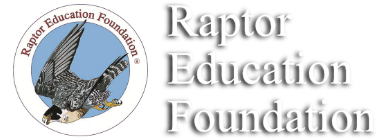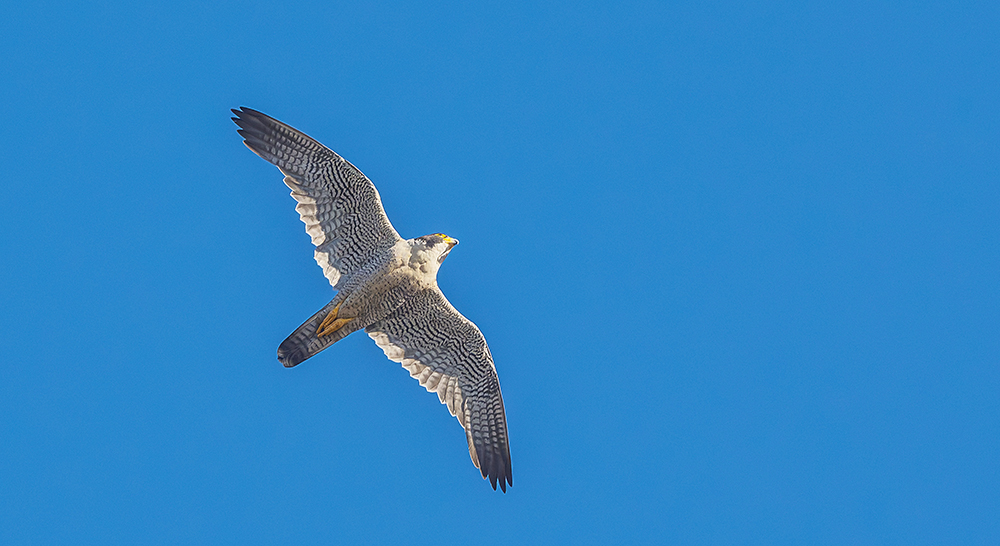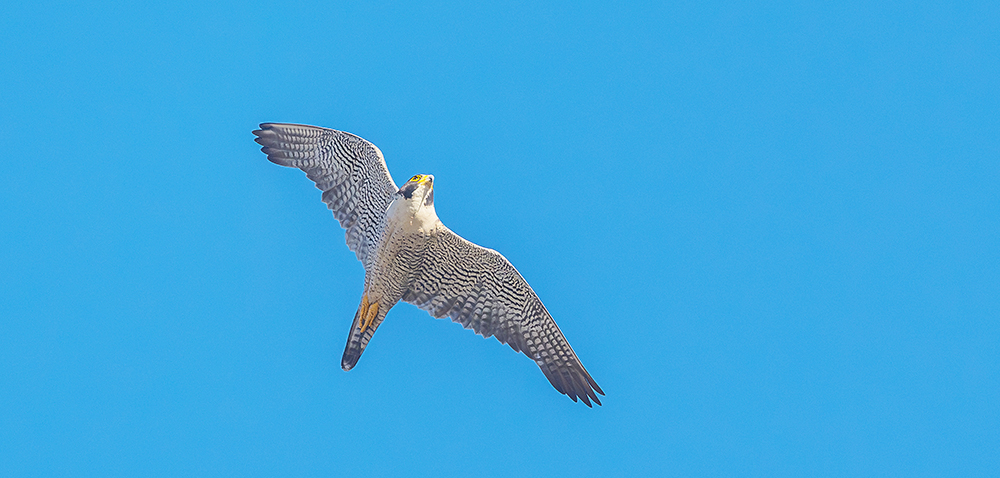Celebrating and protecting the Mile High City’s
first documented nesting peregrine falcons!
Fox News Covers Peregrines
Volunteer Application Page Sponsorship Support Page
June 6, 2024, REF member Jeff Wang captured the two images shown here of the female in the vicinity of 1875 Lawrence, which
is the eyrie location documented in the videos that follow. Jeff’s exceptional skills have captured many beautiful raptor images over the years. Sign up (for free) to receive our newsletter, Raptor Chronicles, which features many of Jeff’s pictures.
Cricket Montague works high up in a steel and glass office tower with a sweeping view of Denver’s skyline. She’s employed with Comerica, a Dallas-based financial services company, and noticed the aerial displays by a pair of large falcons. She watched them for several weeks flying back and forth in regular morning and afternoon patterns. The speeding raptors looked suspiciously like the once-endangered peregrine falcons. They have appeared in the Denver concrete, steel and glass canyons on a random basis, generally in the early spring months. Since 1988, when Colorado Parks & Wildlife attempted a hacking program to get the then-endangered falcons to make Denver’s high-rises their home, no one has been able to confirm any peregrines nesting in the Mile High City.
As a Ducks Unlimited member, Cricket met Anne Price, President of Raptor Education Foundation at a DU banquet and later showed Anne her photos of the falcons taken with an iPhone through binoculars. Anne communicated the information to her colleague Peter Reshetniak, REF’s Director of Special Projects. Peter contacted Cricket and after reviewing more photos, Peter also concluded that these falcons were more than summer visitors to Denver. He quickly organized a meeting with Cricket to get up into her office building with some better optics to see if this was a mated pair. At that time of the year, this almost certainly meant they were taking care of baby falcons. Cricket’s daily observations led her to suspect that a building at the corner of 19th and Lawrence was hosting the peregrine’s “eyrie”, or nesting area. Unfortunately, despite bringing much better optics, and two more experienced spotters, no falcons were visible anywhere from 22 stories in the air. They looked east, west, north and south. Nothing.
Disappointed, they decided to venture down the streets and see if they might have better luck. Walking along 19th Street, Alex Reshetniak looked up and noticed some feathers wafting down from the south side of the federal courthouse. He quickly got his binoculars and confirmed a male peregrine falcon plucking its prey, just beneath the roofline of the courthouse some 20 stories above the ground. Peter set up his camera and with his 1365-millimeter lens he was able to zoom in and record the video sequence you can see in the second of the 5280 Peregrine Watch series below.
Over the next week Cricket monitored the suspected building housing the probable nesting site, and Peter was able to observe food deliveries. Other falcon behaviors confirmed the building as the site of the nest. However, because of how the structure is configured, it was impossible to see any young falcons. After contacting the building’s management company, Peter was able to get up onto the level where the big falcons had set up home. Going outside onto the narrow walkway that provided access to that level was unfortunately not possible. After talking with the building engineers, Peter learned that the peregrines had been using this building for at least four years! Raising baby falcons during those years could not be confirmed. Anyone venturing out onto that walkway was immediately reminded that they were on forbidden grounds, as one or more of the big falcons would harass the human intruders. The safety cable which encircled the upper level couldn’t certified for use, because the peregrines would immediately defend their territory. Peter is currently working with the management and owners of the building to get at least one camera placed so that the age of the young falcons can be determined.
A subsequent conversation with Wayne Soong, District Wildlife Manager (Denver environs) with Colorado Parks & Wildlife indicated he had been informed that a peregrine nest had been active last year on the SalesForce building which is quite close to the current location. It would be logical to assume that the same pair has decided to move their nursery to a better location or one with more affordable costs per square foot and better amenities?
Within the next few weeks one or more young peregrine falcons will make their first attempts to fledge the nest. These first flights will be fraught with danger. Although Mom and Dad have obviously mastered the reflections of glass windows, shifting shadows, and bright sun, a sudden wind gust could blow an inexperienced flier into a building. REF will be setting up a team of peregrine monitors to stand by should a crash landing occur. Getting the young birds to safety if they land on any of the busy streets and getting them to an experienced avian veterinarian quickly, should the need arise, will be critical for their survival during those first couple of weeks of flying. You can be part of this safety net for Denver’s first nesting peregrine falcons. REF will be raising funds for cameras, web service and tech support, binoculars, staff time, veterinary care and monitoring staff expenses. Thanks to Cricket Montague, Chris Schiller, Alexander Reshetniak and Peter Reshetniak for confirming this historic first for Denver. Stay tuned for more exciting falcon footage. Denver is officially home to the fastest avian predators in the world!
Volunteer Application Page Sponsorship Support Page
Special thanks to Unico Properties LLC, for being Denver’s peregrine “eyrie” (nest site)!
As referenced in the first video of this series (above), the male peregrine falcon is shown here feaking (cleaning his beak) after plucking a small bird and delivering it to the nest site. He dropped lunch off, and quickly returned to this spot where he could relax, clean his beak of any pieces of lunch, and then do a full preen of his feathers. You may also notice that occasionally his eyes appear white. He closes the bottom lid upwards and grabs a little shut eye. We don’t know how many young falcons he and the female are feeding at this point, but it will require a lot of hunting to keep even one young peregrine growing well. Their food will be birds in and around the city. This includes the pigeons everyone associates with city habitat, to more exotic fare like small ducks, northern flickers, robins, starlings, and so on. Not only do the parents have to feed one or more growing falcons, they have to feed themselves. Being a successful peregrine parent in any habitat is hard work!
Special thanks to Unico Properties LLC, for being Denver’s peregrine “eyrie” (nest site)!
More Videos coming. Come back regularly to see the fastest avian predator in the world living in Denver!
In this video, you’ll see the falcon we believe to be the male, hanging out on the back side of the ledge containing the area where the babies are. He is very busy, repeatedly making hunting forays around 1875 Lawrence, and periodically walking down the slanted interior section of the ledge to check on the young. He has very prominent “malar” marks, or the two dark stripes running from his eyes down to his throat area. Malar marks are present in almost all falcon species around the world, and help cut down on the glare of the sun while falcons are hunting birds in the air. That’s why football and baseball players do the same thing, albeit with greasepaint or tape. At 2:25, Dad slowly opens his wings for a stretch, before lifting off into the air. Check out the narrow, long wings which are so characteristic of falcons!
Volunteer Application Page Sponsorship Support Page
More great footage of Dad! At 0:26, we see him lift up his feathers, and shake everything very quickly. This is called “rousing” in birds, and it typically indicates comfort with their environment. Particularly in the case of falcons, it’s also something they do right before taking flight, as you’ll see. Later we see him on the glass partitions of a building under construction close to 1875 Lawrence. It’s pretty windy, but truly amazing to watch how he maneuvers on the narrow glass edge of the balcony, all while keeping his balance. As always, he’s looking for something to eat, or a possible intruder into his sky kingdom.
Sixteen stories above the ground, this is the first view of one of the young peregrines! Two babies have been sighted, however, the younger one is not yet capable of getting up to join its sibling…yet. The older baby is testing out his/her wings and clearly getting ready for flight. However, the wings and tail are only about two-thirds of the way grown in. In order to maneuver around the buildings, and navigate the winds, updrafts, etc., this juvenile will need a fully-grown set of remiges (wing feathers) and retrices (tail feathers). Mother Nature helps out in this area, and gives young raptors a set of feathers which are actually LONGER than that of their parents. Every extra square inch of flight surface will help in the coming weeks. You can see that this baby’s head is still covered in white, downy feathers. Soon, almost all of that will disappear, as the long wing and tail feathers grow to full length. The plumage of the juvenile peregrines differs from that of the parents; their wings and tails are brown, with cream and brown striped breasts and bellies. The “cere” or the skin which connects the beak to the face, is also a pale, bluish-gray, along with the orbital ring, which is the bare skin around their large, dark eyes. The adult falcons have bright yellow ceres and orbital rings. This youngster seems to be in a hurry to grow up, for sure!
Fresh video recorded on June 23 in the early morning along with some great stills by Jeff Wang shot earlier in the week shows our parents still hard at work bringing food back to the eyrie. Although one of the young falcons took a first flight, or slipped or was blown out last week (covered in Raptor Chronicles), but at least one is still on the hidden shelf. We also are guessing that the male who took the early plunge into freedom has returned back to his protected nursery with food deliveries included. We continue to monitor as best we can and will report as soon as more news develops. The video shows both adults playing in the glass and steel canyons just to the east of their nesting site. Despite the city noises, they could be heard quite easily if you were within a hundred yards of where they were slicing through the morning air.
Peter shot all of this video except the close ups of REF’s peregrine, on June 26 between 6:00 and 8:00 PM. For those of you curious about the equipment Peter uses, all of the footage was shot with the same camera (Canon SX 60 HS), but the resolution differences result from the density of light on the subject. Those of you into physics need only remember that the matter composing everything you see is just frozen light! That’s one of the most interesting theories…
Enough of that. The female is perched 30 stories up on the Xcel building. In the video you’ll see that the wind is strong, but she’s preening herself very fastidiously as she balances on a cement, steel, and glass cliff in her urban habitat. It’s critical for raptors to keep their hunting tools (legs, feet and toes) clean and free of leftover food. At about 2:19, she opens her wings and appears to be reacting to something off camera. It could be an approaching hawk in the distance, or perhaps she saw her mate cruising by with food. Yes, apex predators can and do adapt to our cities! The question is: can we adapt to them living with us?
The final image is from the camera which the building owners have placed directly above the nesting area. Two babies were recorded on the camera, and one of the youngsters was assisted by REF’s Anne Price in getting back to safety after its first flight ended 16 stories down on the sidewalk. Thanks to the fire fighters of Denver Fire Department Station #4 for making their building available as a safe site for relocation. HUGE thanks to the Hensel Phelps construction crew for making sure the male fledgling was protected when they saw him land on the sidewalk across from their new building. See REF’s Raptor Chronicles for the full story of the rescue on June 18th; you can subscribe for free on our web site. The story can also be viewed by going to the Raptor Chronicles Archives on our home page: www.usaref.org P.S. The two fledglings are not far from home. They are learning to hunt for themselves by watching their parents. They may periodically return to their nursery. Peter is visiting on a regular basis to see if he can catch them in the “hood” before they migrate south for the winter. Stay tuned.
Back to the the first sighting of the female peregrine that led us to the discovery of the eyrie location! Alex Reshetniak noticed feathers floating down to street level from the top of the new federal courthouse. Looking up, he saw the peregrine plucking lunch. At the end of this video, as Peter panned over to the entrance of the federal courthouse, the female flew straight west up 19th Street into the 1875 Lawrence Street eyrie location. She carried part of the bird she was eating, dropped it off, and in a few minutes, she returned back to the courthouse where she began to preen and nap.
Volunteer Application Page Sponsorship Support Page
Special thanks to Unico Properties LLC, for being Denver’s peregrine “eyrie” (nest site)!
More Videos coming. Come back regularly to see the fastest avian predator in the world living in Denver!


